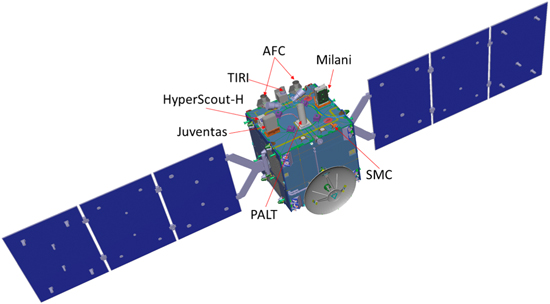Hera spacecraft design. The locations of the different payload elements are indicated (AFC = Asteroid Framing Cameras; TIRI = Thermal InfraRed Imager; PALT = Planetary ALTimeter; SMC = Small Monitoring Cameras). (figure 6, extract from The Planetary Science Journal)
The ESA Hera Mission: Detailed Characterization of the DART Impact Outcome and of the Binary Asteroid (65803) Didymos (a new publication in open access):
Hera is a planetary defense mission under development in the Space Safety and Security Program of the European Space Agency for launch in 2024 October. It will rendezvous in late 2026 December with the binary asteroid (65803) Didymos and in particular its moon, Dimorphos, which will be impacted by NASA’s DART spacecraft on 2022 September 26 as the first asteroid deflection test. The main goals of Hera are the detailed characterization of the physical properties of Didymos and Dimorphos and of the crater made by the DART mission, as well as measurement of the momentum transfer efficiency resulting from DART’s impact. The data from the Hera spacecraft and its two CubeSats will also provide significant insights into asteroid science and the evolutionary history of our solar system. Hera will perform the first rendezvous with a binary asteroid and provide new measurements, such as radar sounding of an asteroid interior, which will allow models in planetary science to be tested. Hera will thus provide a crucial element in the global effort to avert future asteroid impacts at the same time as providing world-leading science.
Abstract from: The Planetary Science Journal (open access), 3:160 (21pp), 2022 July.
Authors: Patrick Michel, Michael Küppers, Adriano Campo Bagatin, Benoit Carry, Sébastien Charnoz, Julia de Leon, Alan Fitzsimmons, Paulo Gordo, Simon F. Green, Alain Hérique, Martin Jutzi, Özgür Karatekin, Tomas Kohout, Monica Lazzarin, Naomi Murdoch, Tatsuaki Okada, Ernesto Palomba, Petr Pravec, Colin Snodgrass, Paolo Tortora, Kleomenis Tsiganis, Stephan Ulamec, Jean-Baptiste Vincent, Kai Wünnemann, Yun Zhang, Sabina D. Raducan, Elisabetta Dotto, Nancy Chabot, Andy F. Cheng, Andy Rivkin, Olivier Barnouin, Carolyn Ernst, Angela Stickle, Derek C. Richardson, Cristina Thomas, Masahiko Arakawa, Hirdy Miyamoto, Akiko Nakamura, Seiji Sugita, Makoto Yoshikawa, Paul Abell, Erik Asphaug, Ronald-Louis Ballouz, William F. Bottke, Jr., Dante S. Lauretta, Kevin J. Walsh, Paolo Martino, and Ian Carnelli.
Acknowledgments: Hera is the ESA contribution to the AIDA collaboration. Hera, Juventas, Milani, and their instruments are developed
under ESA contract supported by national agencies. This project has received funding from the European Union’s Horizon 2020 research and innovation program under grant agreement No. 870377 (project NEO-MAPP), the CNRS through the MITI interdisciplinary programs, ASI, CNES,
JAXA, the Academy of Finland project no. 335595, and was conducted with institutional support RVO 67985831 of the Institute of Geology of the Czech Academy of Sciences. M.L., E.P., P.T .and E.D. are grateful to the Italian Space Agency (ASI) for financial support through Agreement No. 2022-8-HH.0 in the context of ESA’s Hera mission. We are grateful to the whole Hera team, including Working Group core members and other contributors for their continuous efforts and support.

